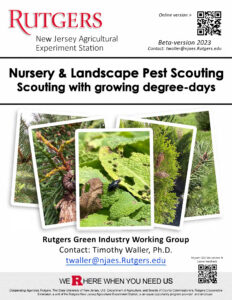- Serious potential for Boxwood Blight
- Bronze Birch Borer (BBB) approaching adult emergence
- Clearwing Borer adult flight – time to monitor
- Red-headed flea beetle (RHFB) egg hatch – adult emergence soon
- Oomycete material considerations
- (click the ‘Read More’ below for complete dates in S-C-Northern NJ per pest)
Still time to Sign up for the 2025 – Rutgers Ornamental IPM Program
(Join us for the next Session Tuesday 5/13/25)
Note we have Clearwing borer lures and wing or delta traps, scale crawler tape, and yellow sticky cards available to commercial grower program members at our Cumberland (twaller@njaes.rutgers.edu) and Monmouth (william.errickson@njaes.rutgers.edu) RCE offices.
- Click here for a PDF of April 22, 2025 webinar (contains information on RHFB and early Clearwing borer treatments) Click here for VIDEO of April 22, 2025 webinar
- Click here for a PDF of April 08, 2025 webinar (Contains information on aphids and boxwood leafminer) Click here for VIDEO of April 08, 2025 webinar

